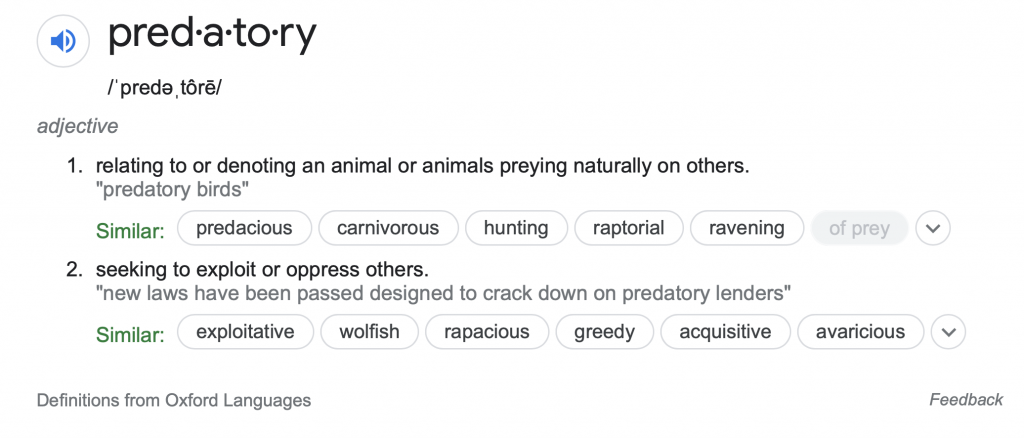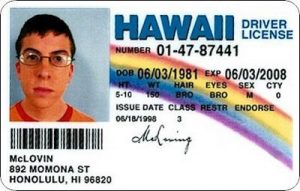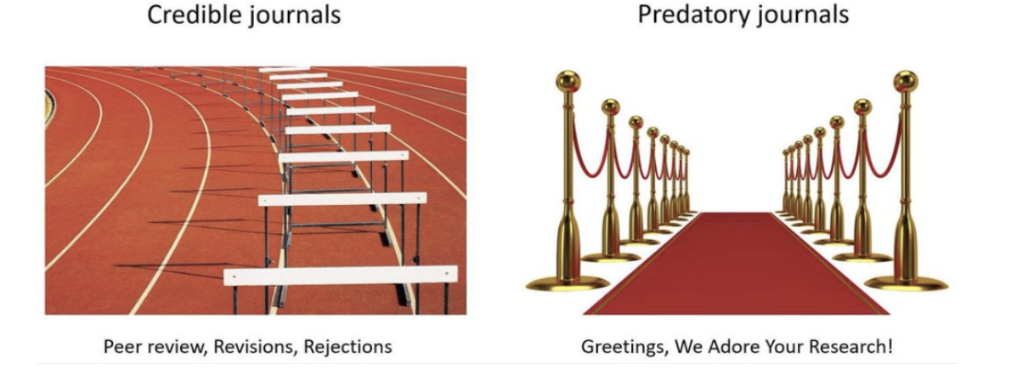Unit 3: Getting to, and thinking critically about, the [Secondary] Research
12 *Publishing and Predators
Ya know. Back in the olden days when I first started on the path to phd…these things didn’t even exist! But in academia it’s “publish or perish”, i.e., publish to in order to get tenure, aka publish or lose your job. Somewhere along the line someone figured out that potentially perishing is a pretty powerful motivator, and used that knowledge to prey on researchers. 
Learning Objectives
To know what a predatory journal is and how to verify your source.
- Peer Review
- an unbiased review (usually) involving anonymous reading and reviewing [1] of research articles by other scientists
What is a Predatory Journal?
Predatory Journals accept virtually any article as long as they are paid to publish that article. They are unreliable sources of information. Some things to check for are:
- Do they publish legitimate articles?
- Are they unclear about the cost: Article Processing Charge?
- Do the articles have weak and/or poorly formatted citations?
- Have articles been peer-reviewed?
- Are the published articles meant to misinform (propaganda, “fake news”)?
- Does the publisher send out unsolicited emails?
- Do the articles include many spelling errors?
- Is the editorial board listed? Do those scholars actually exist? Do they know that they’ve been listed as a part of this editorial board?
So, the journals and articles may look completely legitimate, but they could be full of misinformation, bad methodology, inaccurate sampling, and false or incorrect citations. Peer review is essential!
You might be able to check out a journal through one of the websites designed to help evaluate publication outlets. For example, try: https://doaj.org/ or https://thinkchecksubmit.org/books-and-chapters/
McLOVIN
Example contributed by: Hannah Acker and group, Fall 2019

The McLovin ID from the movie Superbad is fake. No doubt about that. Countless aspects point out its illegitimacy, such as the single name, McLovin, the state he picked, and the poor photo quality. These mistakes and easy to spot because ID’s have a format and rules about layout. These dead give-aways can also be spotted in citations. Citation format recognition is important in determining the validity of sources.
Another issue with predatory journals is lower standards. Remember that whole “peer-review” thing we talked about? Not as much of a “thing” in outlets that make money from accepting your work. Here’s an outstanding student creation that illustrates this issue:
(Jada Maldonado, Fall 22)
You can verify a source by:
- Using lateral reading
- Check who the authors/contributors work for [example used in recorded lecture]
- Check for errors in format
- Checking if it an academic source
- Examining authors’ scholarly history and presence in academia
Another important thing in this chapter is APA formatting.
The correct format for APA Bibliography is:
Author surname, initial(s). (Year). Article title. Journal Title, Volume Number (issue or part number, opt.), page numbers. DOI
or Retrieved from URL
*Note: DOI only included if the article is online. DOI is preferred
Key Takeaways (no really, I fished this message out of my spam 9/15/2020
Dear Dr. Magsamen-Conrad Kate Greetings from the Journal of Nanotechnology and Smart Materials…!!
We came across your profile through one of your published articles entitled “Mobile technology adoption across the li”. We perceived that the scope of the journal is parallel to your research interest and your experience will be a critical addition to bring out the best citation to the Journal.
JNSM is accepting manuscripts for its upcoming edition Volume 4, Issue 1. We are writing this proposal to endorse your research in a particular field.
Unit 3: Getting to, and thinking critically about, the [Secondary] Research
- ok, so, I've been working with some folks in public health and don't you know one of the manuscripts we sent out came back with a NAME on the review. WHAT??? I was pretty floored because that's not at all the norm in the communication discipline. However, it just points out how tricky all of this is. One thing we're doing in com is moving toward naming reviewers on published scholarship. Part of it is a '...where c[pb_glossary id="1619"]self-reflexive[/pb_glossary]redit is due' thing, but another part is related to diversifying scholarship, challenging bias and paradigmatic lines. So, stay tuned. Maybe in the future this definition will become more complicated! Hey, at least you should be able to see that science really is self-reflexive! ↵
an unbiased review
